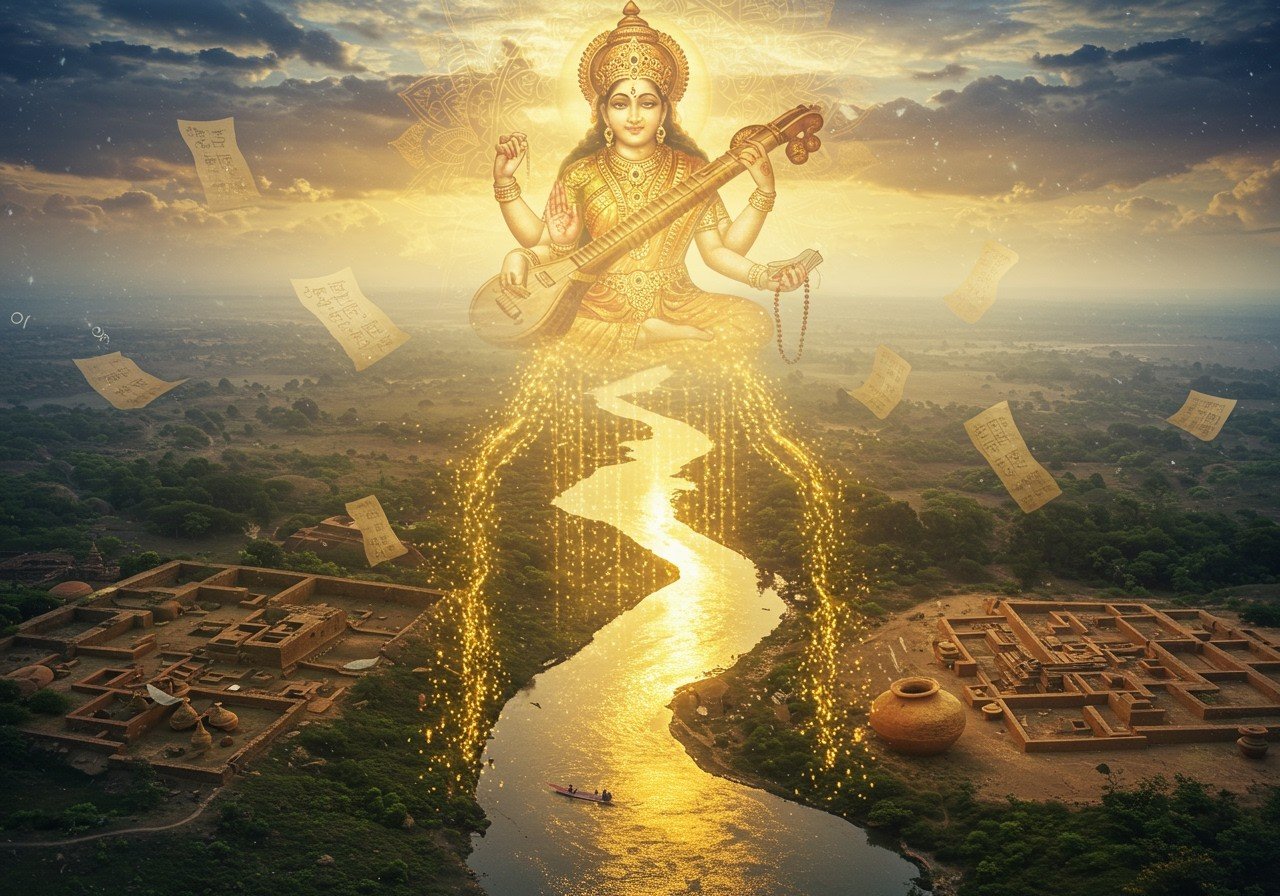
The Saraswati River, a blend of myth and reality, holds a revered place in Indian tradition. This sacred river, mentioned in ancient texts, is a symbol of purity, wisdom, and knowledge. Let us explore the spiritual significance of Saraswati as a goddess and the ongoing scientific quest to understand her river’s physical past.
What is the Saraswati River?
The Saraswati River is described in ancient Indian scriptures as a life-giving entity, essential to both physical and spiritual sustenance. The Rigveda depicts it as a mighty river flowing from the Himalayas to the sea. Other texts like the Mahabharata and Manusmriti offer glimpses into its possible ancient course and its role in shaping the spiritual landscape of the region. This river is deeply intertwined with Hindu rituals and is closely associated with Saraswati, the goddess of wisdom.
Archaeological evidence suggests that Indus Valley Civilization sites flourished along the Saraswati’s banks. Understanding how this river is portrayed in historical texts unveils its deep impact on Indian heritage. This exploration takes us on a journey through geographical descriptions and archaeological discoveries, connecting us to the profound influence the Saraswati River has had on Indian culture and spirituality.
Where is Saraswati Nadi?
The search for the Saraswati River’s ancient course involves scientific and historical investigations, revealing a captivating story. Advanced technologies like satellite imagery and remote sensing have identified traces of paleo-channels in the Indian subcontinent, potentially belonging to the lost river. The Ghaggar-Hakra River system appears particularly promising, believed by many to be the Saraswati’s remnants.
Geological studies support this theory. Satellite images reveal a significant river that once flowed through the Thar Desert. Analyses of sand from 3-10 meters below the surface of the modern Ghaggar River, conducted by researchers from the Physical Research Laboratory (PRL), Ahmedabad, and IIT-Bombay, confirm that it was once a perennial river fed by glaciers. This evidence points to the river flowing through regions now part of Haryana, Rajasthan, and Gujarat. A remarkable number of Harappan settlements are located along this potential riverbed, further strengthening the link between the ancient civilization and the Saraswati.
Why did the Saraswati River disappear?
The Saraswati River’s disappearance is a complex puzzle with multiple contributing factors. Climatic changes, including shifts in monsoon patterns, likely reduced the river’s flow, diminishing its life-sustaining capacity. Tectonic movements also played a role, potentially diverting water to other river systems like the Yamuna, thereby altering the Saraswati’s course.
Human activity might have exacerbated the drying process. Deforestation and the over-extraction of resources could have further strained the already dwindling water supply. Sedimentary evidence reveals a gradual decrease in flow over millennia. This decline coincides with significant cultural shifts, particularly the decline of the Harappan civilization around 2000 BCE, marking the beginning of the Meghalayan Stage, a dry period in global climate history starting approximately 4,200 years ago.
Cultural and Spiritual Significance
The Saraswati River holds deep cultural and spiritual significance in Indian tradition. It is closely associated with Goddess Saraswati, the embodiment of knowledge, music, and the arts. Festivals like Vasant Panchami celebrate her wisdom and grace.
In art and literature, Saraswati is a symbol of purity and enlightenment. The river’s narrative continues to resonate in Indian philosophy and spiritual practices. Efforts to revive its legacy through cultural and educational initiatives demonstrate its enduring importance to Indian identity. At Poojn.in, we offer a wide variety of products for your Saraswati Puja needs. You can find everything from Saraswati Puja Dashakarma Kits to Khager Pens (Khager Kolom) and more. Explore our collection today to enhance your spiritual practice.
Scientific Evidence and Modern Research
Modern research continues to shed light on this enigmatic river. Interdisciplinary studies combining archaeology, geology, and hydrology are employed to trace the ancient course. Advanced technologies like Geographic Information System (GIS) and radiocarbon dating assist in locating these elusive channels.
Government-backed projects and scholarly publications contribute to validating historical accounts of the Saraswati River. Recent surveys provide valuable insights into its past, while also acknowledging the challenges in definitively proving its existence. The ongoing research bridges myth and reality, enhancing our understanding of the Saraswati through scientific and spiritual perspectives.
The Saraswati River: Frequently Asked Questions
What is the Saraswati River? The Saraswati River, revered in ancient Indian texts, held immense spiritual significance and played a vital role in Vedic traditions. It was often described as a powerful and sacred waterway.
Where is Saraswati Nadi located? It’s believed to have flowed through regions now within Haryana, Rajasthan, and Gujarat. Scientists and archaeologists are actively trying to trace its exact route through these areas.
What led to the Saraswati River’s disappearance? Tectonic plate shifts and climatic changes are believed to have caused the river to dry up over time, altering its course and eventually leading to its disappearance.
Is there evidence to support the existence of the Saraswati River? Yes, various sources, including satellite imagery, geological studies, sand analysis by researchers from PRL and IIT-Bombay, and ancient texts, support the existence of the Saraswati River. These findings have helped researchers map its potential path and understand its timeline, dating back potentially as far as 28,000 years BP.
What is the connection between the Saraswati River and Indian mythology? The river is closely associated with the goddess Saraswati, the deity of wisdom and learning. It’s often seen as a symbol of knowledge, purity, and enlightenment.
Conclusion: Embracing the Legacy of the Saraswati River
The Saraswati River’s story is a journey through science and spirituality. By combining modern technology with historical accounts and archaeological evidence, we gain a deeper appreciation for a river that shaped civilizations and cultures. Poojn.in provides a curated selection of puja items to enhance your connection with this rich tradition. Browse our cotton wicks, clay diyas, and other essential items to create a meaningful and authentic puja experience.
The Saraswati’s disappearance serves as a reminder of the delicate balance of nature and the impact of human actions. Its decline coinciding with the shifts in the Harappan civilization underscores nature’s influence on human history. Yet, the river’s cultural significance endures, celebrated in festivals and cherished through art and philosophy.
As research continues to uncover the Saraswati’s mysteries, we connect more deeply with our heritage. The ongoing exploration of this river, both myth and reality, binds us to our roots and inspires us to preserve the rich tapestry of our traditions. The Saraswati continues to flow through India’s identity, encouraging us to explore and embrace its enduring legacy.


